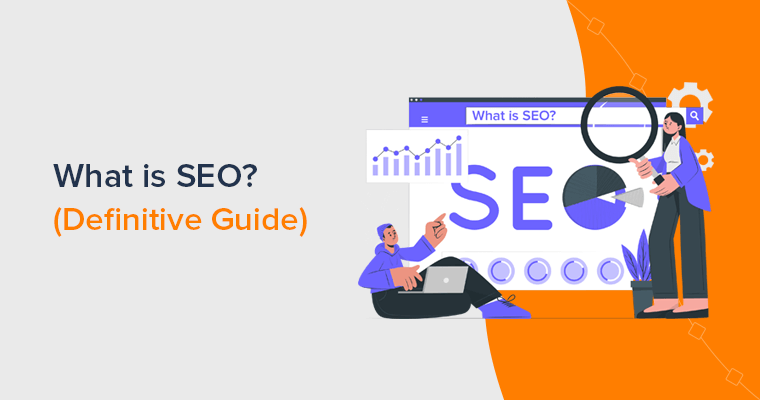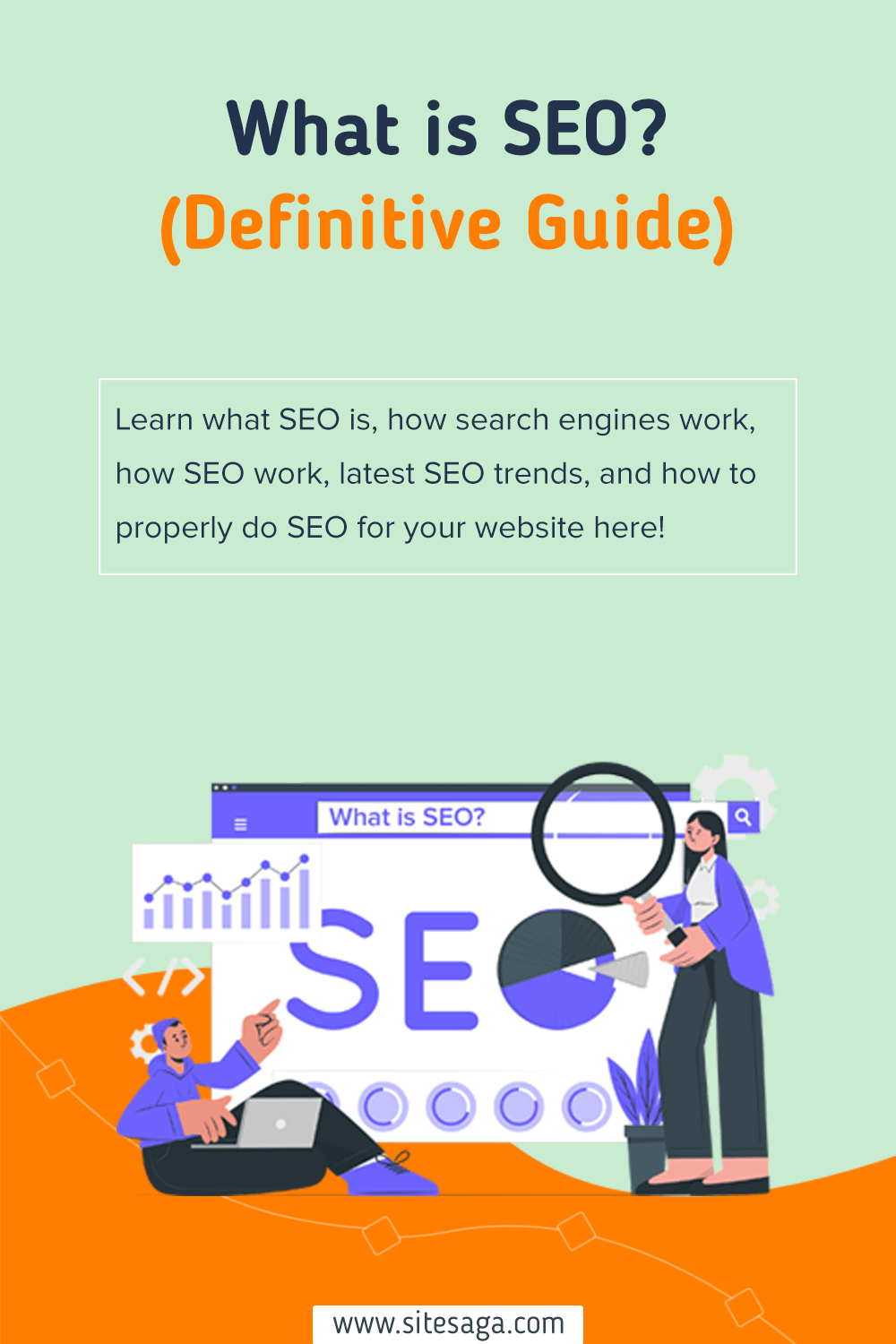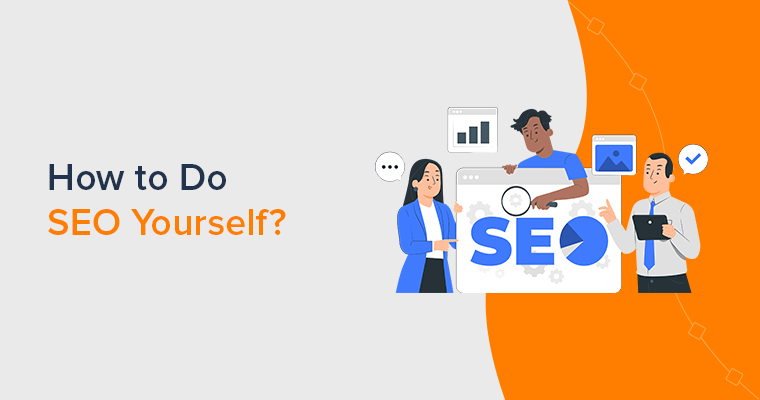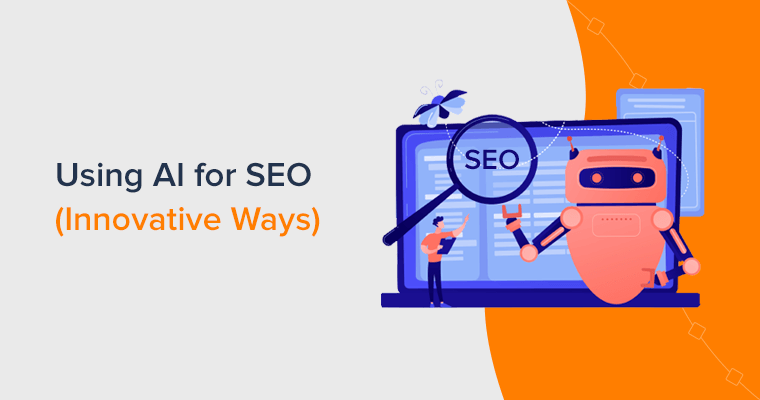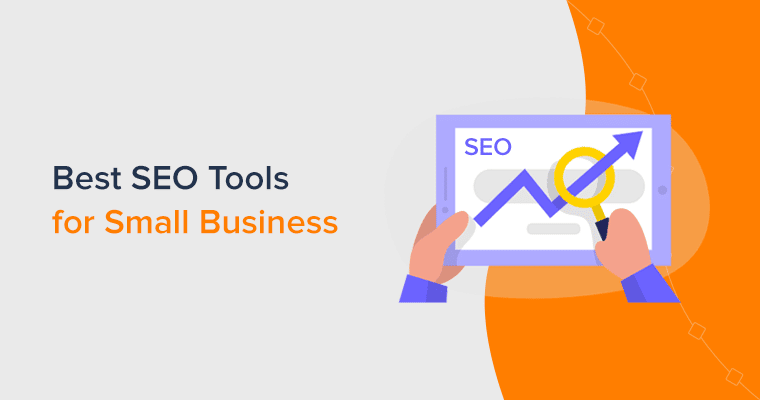Are you wondering what is SEO? Or looking for a beginner-friendly Search Engine Optimization (SEO) guide? Stay right here!
Broadly, SEO is a marketing strategy that helps your website get more traffic by ranking higher in the search engine result pages. Simply, it makes your web pages appear higher on the result pages of search engines like Google, Bing, Yahoo, Yandex, etc.
But why rank better on search results? Well, that’s important because ranking better means more site visitors and more revenue for you.
You see it’s IMPORTANT! Then, how to do SEO for your website? That’s what we’ll teach you.
This guide explains what SEO is, how search engines process users’ searches, how SEO works, and how to properly do SEO for your site. Everything you need to know about your site’s SEO!
Let’s get started.
A. What is SEO (Search Engine Optimization)? – Definition
Simply put, Search Engine Optimization (SEO) is a measure to make your website discoverable with search engines like Google. It involves using various techniques to rank your website to the top of Search Engine Result Pages (SERPs).
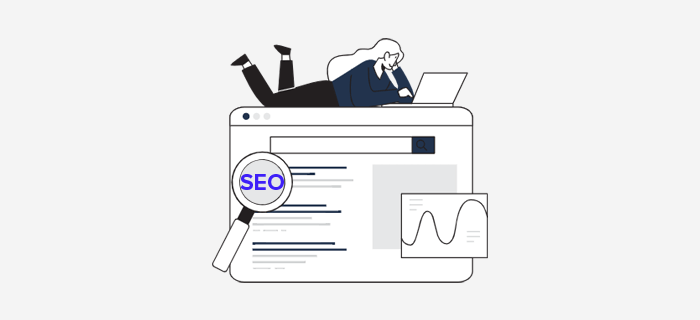
In other words, SEO is the process of refining your website for what it’s called ‘Organic Results‘. The organic result is what search engines display for free and based only on the relevance of the target keyword.
For example, if you search the keyword ‘best website builder’ on Google, then you’ll get a result page like this.
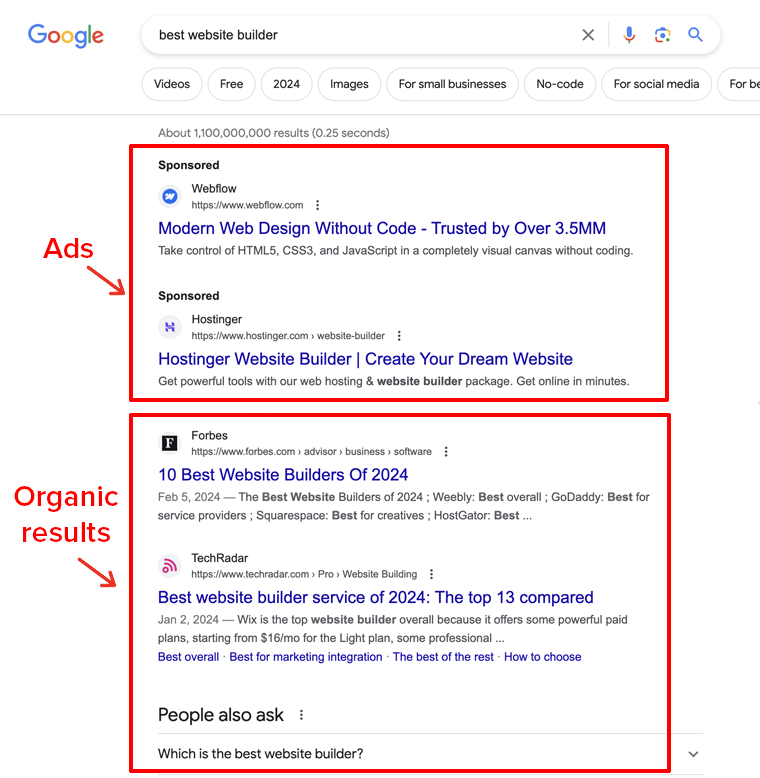
Here, the first few results are advertisements, i.e. a paid result. The results below are organic results which are shown by Google for free. One of which is our list of the best website builders.
In conclusion, SEO means improving your web pages in a way that they can appear on the top of search engines’ free results like above.
Why Ranking on Top is Important?
Now, you might think why ranking your website on top is important. Here are some reasons:
- Increased Visibility: Top search engine rankings enhance visibility, attracting more users to your website.
- Credibility and Trust: Higher-ranked websites are perceived as more trustworthy, establishing credibility with users.
- More Traffic and Conversions: Top rankings lead to increased organic traffic, boosting the chances of converting visitors into customers.
- Competitive Advantage: Outranking competitors in search results provides a significant edge in competitive markets.
- Cost-Effective Marketing: Achieving a high search engine ranking offers a cost-effective, long-term marketing strategy compared to ongoing paid advertising.
Hence, if your site appears at the top of Google’s (or any search engine’s) result page for any search query, then it’s most likely that most users will visit your website. When your website traffic grows, your site revenue will grow naturally.
According to recent studies conducted by Backlinko, the top 3 organic Google search results get about 54.4% clicks. From that, the #1 search result takes over 27.6% of clicks. And, the number goes on decreasing on moving down on the result list.
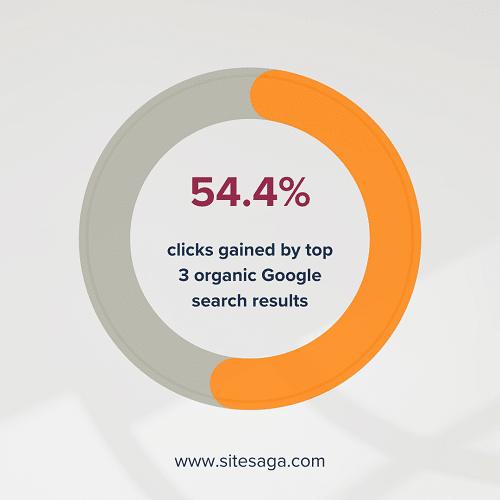
From the study, the users seem likely to visit links that appear on top of the search results. And they seem to escape the results in the latter result pages. That’s why ranking on the top is important to increase the flow of organic visitors to your website.
Plus, search engines are the biggest and best sources of traffic to any site. According to Alexa, Google is the #1 top site that gets most of the internet traffic. The idea is simple, optimize your content for Google’s organic results, and then the users will come flocking to your site.
In a nutshell, SEO is a very effective marketing strategy to drive more internet traffic to your site. It’s also a crucial factor in making a successful website that earns money.
B. How do Search Engines Work?
As you might already know, a search engine is an online software or tool to search for information on the web. Basically, it takes a search query from a user and returns a list of the most relevant results in response.
Some popular examples of search engines are Google, Yahoo, Bing, Baidu, Yandex, etc. Among them, Google is preferred by most and leads the market with over 91.47% of users. The second most preferred search engine, Bing has below 4% of users, according to Statcounter.
In desktop alone, Google shares 85.5% market based on Statistica.

Many search engines have the same way of working. It starts with a search query entered on the search engine. Then, it looks for the web pages related to the keyword in its index (database). The pages are previously stored in its database by scanning the available sites.
The search engine, then, arranges the result with the help of its algorithms. Then, it displays them on the SERP in the arranged order.
To describe the process in detail, the basic tasks of a search engine can be divided into 3 parts. They are:
- Crawling: Visiting every URL and scanning all the web pages it finds.
- Indexing: Copying all the web pages’ content to store them in its index.
- Ranking: Sorting the results of a search in order by quality and relevancy.
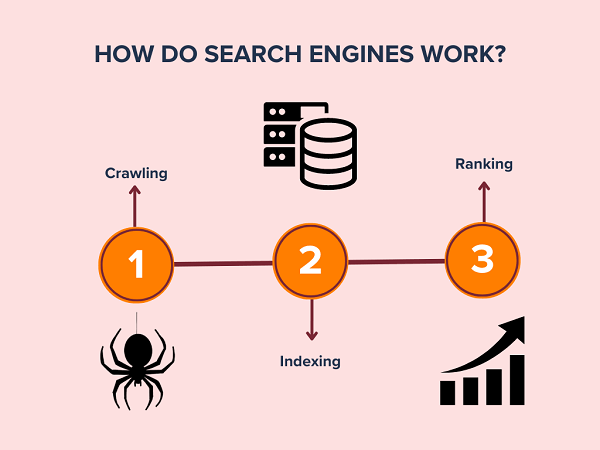
Now, let’s view each step briefly.
1. Crawling
Crawling is the exploring activity of search engines. Google consists of active crawling components often called ‘crawlers’, ‘bots’, or ‘spiders’. They constantly crawl billions of web pages, hyperlinks, and page URLs.
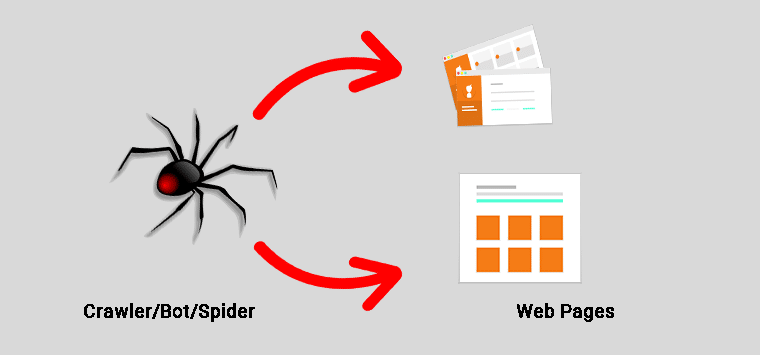
Also, they scan and extract every single link, folder, route, word, and description that they find on web pages. If the bots encounter new hyperlinks during the scan, then they visit them too. (The hyperlink that links a web page to another one of a different website is known as a backlink.)
The bots crawl and scan every accessible hyperlink they find on the way.
How do Search Engines Find Your New Website?
We’ve mentioned that the bots crawl on the previously known hyperlinks and the links found on web pages. So, you might think about how it would crawl on newly made websites with possibly no backlinks.
To help it, Google offers a service called Google Search Console. It is a simple tool with which you can request Google to crawl on your website. Basically, it gives Google a sitemap that contains information about your website pages, last updated time, and other details.
Google Search Console also allows you to check the indexing status and optimize the discovery of your websites.
2. Indexing

After crawling, the scanned web pages are organized and stored in Google’s huge database after treating it with some operations. Some of the operations include:
- Eliminating stop words like a, and, the, etc.
- Noting most repeated words
- Noting backlinks
- Recording freshness and other web page details
Google’s huge database is known as an index and the process of storing web pages in it is called indexing. Importantly, your website has to be indexed by a search engine to be displayed during a search.
3. Ranking
After indexing, the stored data is used to create results from previously indexed web pages for users’ searches.

When a search is carried out, the search engine directs to its index. There, it looks for the most relevant web pages for the entered keyword. Some algorithms (rules) help to arrange the appearing orders of the result. Then, it displays the results in the SERP in the arranged order.
The process of sorting the result based on the algorithm is known as ranking.
The search engine algorithm is a complex formula that determines the results and ways to sort those results in an order. It’s the combination of various ranking factors like high-quality content, backlinks, accessibility, responsiveness, speed, and so on.
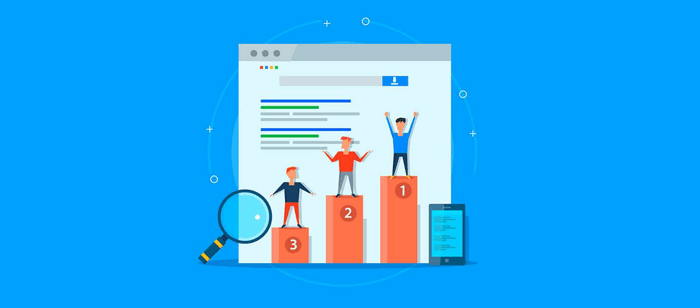
However, the ranking factors are kept secret and constantly updated by search engines.
Every search engine has its algorithm and ranking factors that are different. Due to this, search engines might not give the same result for the same keyword you enter. However, every search engine tries to give you the most useful and relevant results.
Why Search Engines Sometimes Display Faulty or No Results?
But, sometimes you may get a faulty result or something else than what you are searching for. It may sometimes be due to the unavailability of information on the search engine indexes. Or, lack of clarity in your search keywords may also be another cause.
In such a case, you should consider adjusting your search keywords.
C. How SEO Works?
SEO stands for Search Engine Optimization. The name itself is self-evident of how SEO works.
SEO works if you optimize your website the way search engines like it. In other words, it works if you can show the search engines that your content is the best result for the keywords in question.

As stated above, every search engine tries to display the best and most relevant content to the users’ queries. This means if you improve your website content the way search engines consider the best, you’ll win the SEO game.
Now, you might ask how do you know what search engines like? Here is the answer – search engine algorithms and ranking factors tell you that.
Search Engine Algorithms & Ranking Factors
Now, the rank of a site on the result page is determined by page ranking factors.
Every search engine has its algorithm to determine the web page’s rankings in SERPs. The algorithm refers to a complex system that search engines use to sort and fetch content from their index to the result pages in a ranked order. It is a formula combining ranking factors.
For example, Google’s Algorithm is said to have more than 200 ranking factors. Although the official list of the ranking factors isn’t made public, search engines openly announce which types of sites they like.
Some of the most important factors that influence sites’ ranking are:
- Quality of content
- Proper use of headings, title tags, and description
- Site speed
- Backlinks
- Keywords used
- User experience and so on.

As website owners, you should always work on the ranking factors and if necessary, customize your website to meet those criteria.
If your website appears on the first page of results, then you might have done SEO correctly. But, if it’s lagging, then you should improve your SEO measures.
For that, you may need to create quality content with the appropriate use of keywords in blog posts. Also, you can work on other things like link building, site speed, internal links, etc.
Now, let’s see an example of a search query ‘download games for PC‘ on Google.

We can see that Google comes up with 4.5 billion results related to the search. But among them all, these particular sites made it to the top. It’s because they have optimized their site for Google rankings with good SEO measures.
How Long Does It Take for SEO to Work?
You should remember that taking SEO measures doesn’t optimize your site suddenly. But, it takes some time to establish and compete with others to rank well. Sometimes, it may take months or even years to come to a good rank.
And, well-ranked content sometimes moves down the list from SERPs. It happens basically due to 2 reasons:
- Better-optimized content exceeds your content
- Change in search engine algorithms
So, you should use good SEO strategies continuously. It’s important also for your previously ranking pages. With good SEO strategies, you can optimize our site to rank for a longer period, sometimes for months and even years.
The SEO strategies can be divided into 3 types. They are:
- On-Page SEO – Factors you can manipulate and control on your web page
- Technical SEO – Technical aspects that improve the ranking
- Off-Page SEO – Factors that are beyond your website
Find the differences between on-page SEO vs off-page SEO and content SEO vs technical SEO here!
Most of them are explained as well, so keep reading!
D. On-Page SEO Basics
On-page SEO is the practice of managing your web page to optimize it for search engines. It focuses on creating quality content and enhancing user experience.
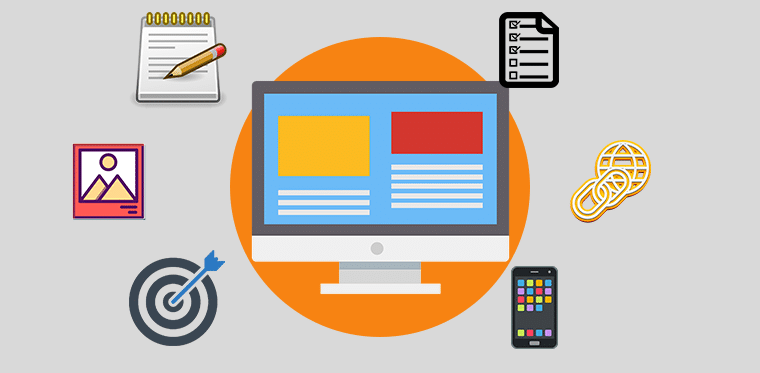
On-page SEO factors include elements that are under your control as a website owner. Basically, every SEO measure that you can implement on your own website comes under On-page SEO.
Significance of On-Page SEO
Google’s ranking factors and algorithms have been evolving and changed a lot over the years. It has become much smarter now for searching and ranking the results. This checks tons of on-page elements as the page ranking factors now.
So, you should take care of many conventional as well as new additional factors on your page.
Key On-Page SEO Elements
Now, here are some of the most effective on-page SEO practices you can apply to optimize your website.
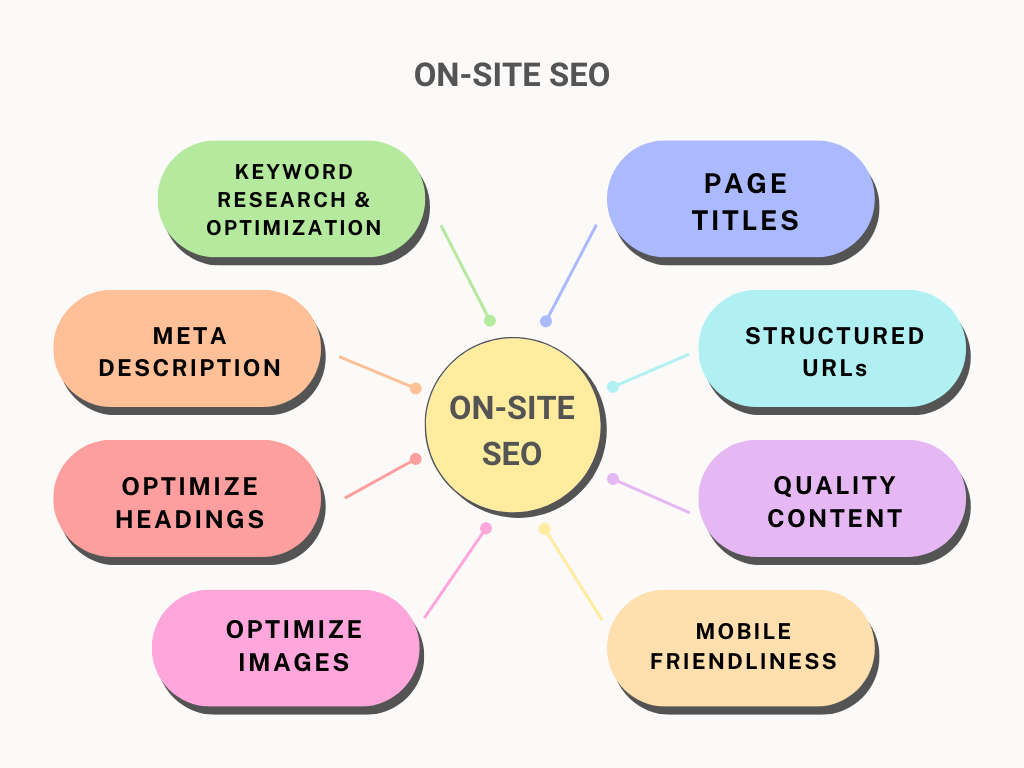
1. Creating Quality Content
Firstly, your website content should be readable and provide the content that readers are searching for. In other words, your webpage should fulfill the user’s intent for that particular search.
Besides, you should write your content in your own words. Your original content first stands out in the crowd among your competitors.
Secondly, make it free from ‘Plagiarism‘. Plagiarism, which means copying other peoples’ ideas and work, can harm your page’s SEO. Google’s algorithm is designed to detect duplicate content and negatively rank the plagiarized web pages.
For example, take the help of tools like DupliChecker. Others include Small SEO Tools.

Next, having useful and engaging content on your web page attracts visitors. They tend to stay on your site more if you have something useful and interesting in your blog posts.
For that, you can write catchy intros, keep clear headings, and use beautiful infographics, pictures, videos, and GIFs.
2. Title and Heading Tags
The HTML title tag indicates a webpage’s title that’s visible in the browser’s title bar. It aids search engines in understanding the pages’ content. Also, it helps in forming the initial impression for users across search engine results, browsers, and social networks.
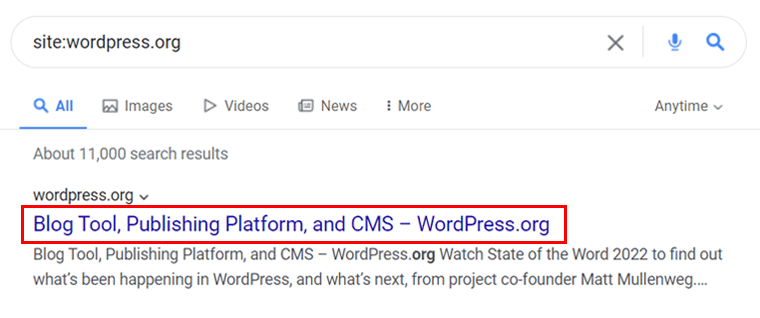
Here are some guidelines for optimizing title tags:
- Ensure that each page has a distinct and informative title relevant to its content.
- Avoid keyword stuffing, as this can create an unnatural appearance and potentially lead to penalties from search engines like Google.
- Aim for titles with 8-12 words and 50-60 characters, containing relevant phrases with significant keywords.
- Make titles clear and precise, utilizing a mix of uppercase and lowercase characters.
- Instead of solely focusing on search engine perspectives, prioritize understanding and addressing user intent when crafting titles.
By adhering to these practices, you can optimize your title tags for both search engines and user experience, striking a balance that enhances visibility and user engagement.
Learn what a website title is here!
Similarly, heading tags help in organizing and enhancing the readability of a webpage by marking the headings of various paragraphs or sections. With a range from H1 to H6, these tags create a hierarchical structure for content.
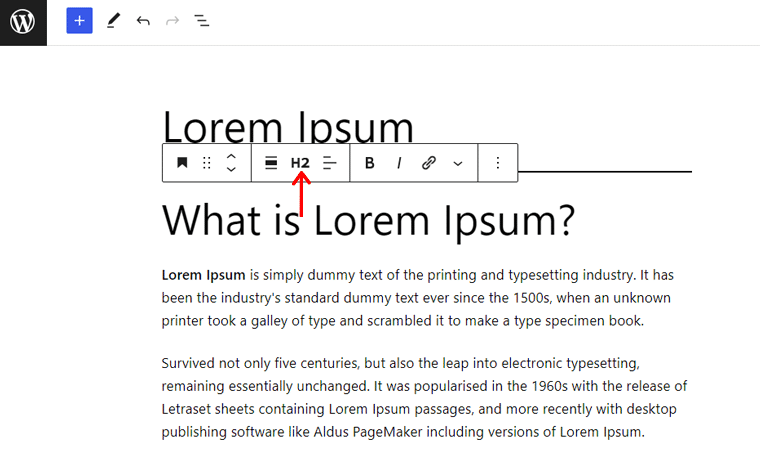
Here are some guidelines for optimizing heading tags:
- Maintain the proper sequence of heading tags (H1 to H6) to ensure a logical structure. For example, follow an H1 tag with H2, not H3 or other tags.
- Each heading should address a specific topic, incorporating relevant keywords to enhance both user and search engine.
- If the default styling of heading tags is unsatisfactory, then CSS styling can be utilized to customize their appearance, ensuring a visually appealing design.
By adhering to these practices, you can effectively use heading tags to structure your content, improve navigation, and optimize both user experience and search engine visibility.
3. Meta Description
Google states that meta keywords and descriptions are not considered direct ranking factors. However, implementing well-crafted meta tags remains a valuable practice. Because they play a crucial role in providing a descriptive and enticing preview for users.
In addition, meta descriptions provide concise summaries of page content that influence click-through rates. So, ensure you keep them within the range of 145 to 160 characters, make them unique, and include the target keyword a few times. Say no to keyword stuffing!
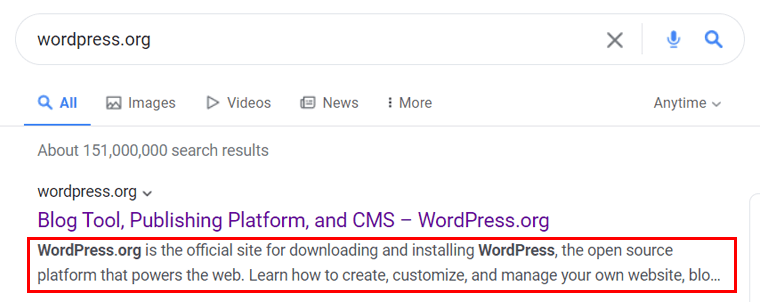
4. Keywords Optimization
As mentioned, keywords are important factors for relevancy. For ranking, you should include the target keyword in the titles, meta descriptions, body, and subheadings. Target keyword means a search term or query for which you want your content to rank on search results.
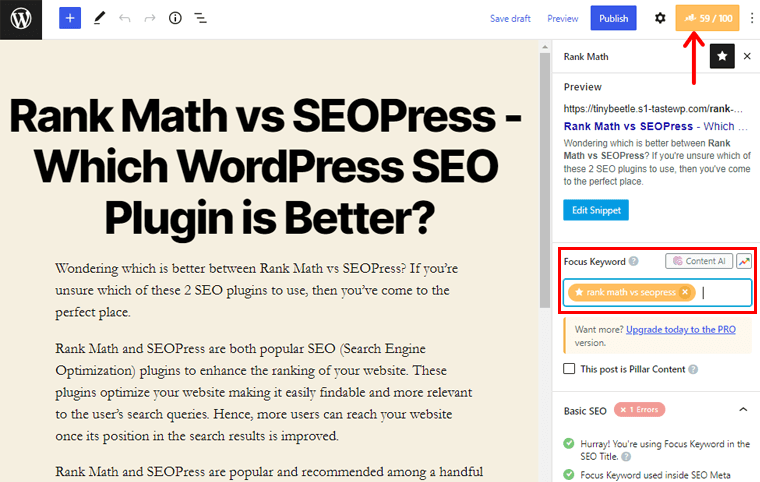
Normally, people advise using the keywords frequently so that Google would think it’s important and try to rank it higher.
But, be careful. You might not want to overdo it. Because stuffing the keywords more densely in your article degrades your page rank.
Alternatively, you can fill your article with closely related words known as LSI keywords. They do a job of telling Google what your article is related to. With them, Google will better understand what your page is about and decide whether to display it on the result pages.
For example, your content is about ‘Apple’.
Now, let’s say it contains words like Apple phone, iPhone, Apple Watch, etc. With this, Google will understand that the article is about the giant company but not the fruit.
That’s why including LSI keywords is important.
For finding LSI keywords, there are various keyword research methods. Best of all, you can use various keyword planner tools available on the web. To name some, Ubersuggest, LSIGraph, SEMrush, etc are good LSI keyword finder tools.
Learn how to add keywords to websites in this complete guide! Find the best SEO tools here!
5. User Interface Design
A good user interface is likely to enhance the users’ experience. They are likely to stay longer on appealing sites with good looks, feels, and easy navigation. Not only that, but users may also keep coming back in the future.
If your site is difficult to navigate or visually unpleasant, then visitors may leave your pages soon. This reduces the visitors’ time spent on your site. This leads visitors to escape your site quickly without interaction causing a phenomenon called a bounce.
With a higher bounce rate, Google understands that your site lacks quality. So, it negatively affects your site ranking.
Learn how to improve the user experience of a website here!
6. Optimizing URL
Most of the blogging platforms let you edit the URLs of pages and blog posts. The URLs are also called permanent links or permalinks. But, you should be careful while editing the permalinks. It’s because you should not edit it once published.
While writing custom URLs, always remember you have to make them clear and understandable to the readers. Thus, you have to keep it short and clear. Also, remember to include the main keyword in the URL or permalink.
For example, if our main keyword is ‘wordpress vs medium’, then we can have a permalink structure like this.
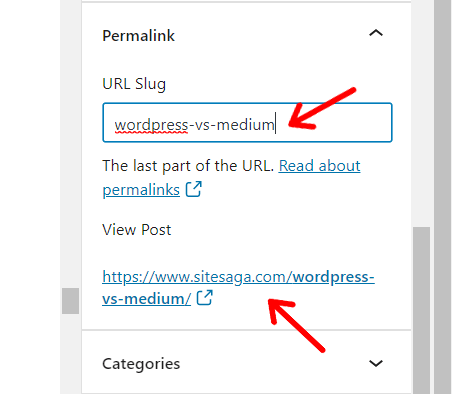
Also, optimizing the title tags and Meta tags is good for SEO ranking.
The title tags and meta tags should necessarily include the focus keyword. It makes users clear about the webpage content and also tells Google what the content is about.
7. Using Internal and External Links
Linking pages to your content lets users visit other pages. It is a way of promoting other web content.
Internal links are the links from one page to other pages within the same website. The pages with less engagement and visitor reach can be linked to other well-ranked web pages. This way, it is discovered by visitors. Also, Google gets to crawl the linked content better.
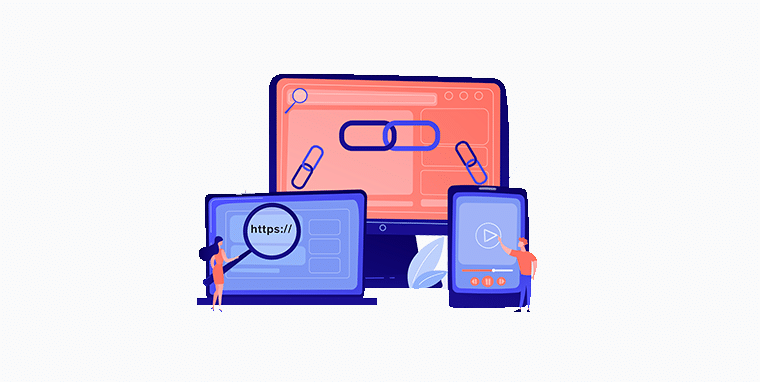
Likewise, external linking is the linking of pages from a webpage to another page of a different website. You can link other external web pages to your site if you think that’s useful and necessary for your users.
By adding external links, your visitors get to access quality content that other websites provide. Also, you’ll get a good connection with the other domains.
Here’s a guide on how to fix broken permalinks in WordPress.
8. Optimizing Images
The optimization of images is also important for SEO rankings. First, you should use images of small sizes. This makes your webpage load faster and increases page speed.
Besides, you should use a matching descriptive name for the image. Also, consider giving a proper alt tag for images. (Alt tag is the text that appears in place of images when the images don’t load. It happens if the image is deleted, lost, or corrupted, slow internet speed, etc.)
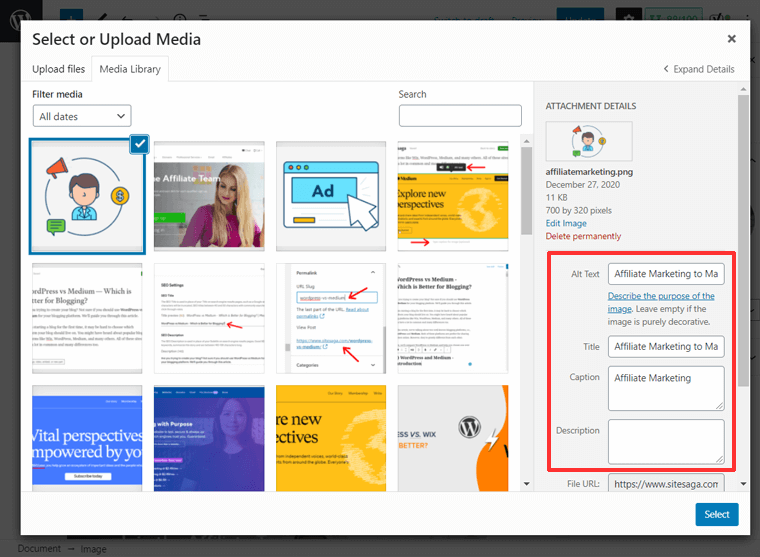
Both good names and alt tags make search engines clear what the image is about. Thus, it shows the relevance of the images and therefore, helps to rank higher.
Take help of the image optimizer WordPress plugins for compressed yet quality images.
9. Video SEO
Simply, video SEO means optimizing your video to rank higher in search engines for a certain target keyword. Video SEO aims to achieve video views by ranking on regular search engines as well as Google’s video publishing and searching platform YouTube specifically.

Google can rank videos from video sharing platforms like YouTube, Vimeo, Twitch, etc. Among them, YouTube is the most popular platform used by most people. So, optimizing your YouTube videos on Google is most beneficial.
Nowadays, videos have become a great way of marketing. So, it is used by many online marketers to promote their business, products, and services.
Here’s a list of the best WordPress video conference plugins to check out.
As a matter of fact, video SEO is not directly useful for leading traffic to your site. However, video ranking and views come handy when it comes to brand awareness and recognition. Thus, video SEO is an important aspect of your website growth.
Nowadays, most web owners use some kind of embedded videos on their website front page, blog posts, and other pages.
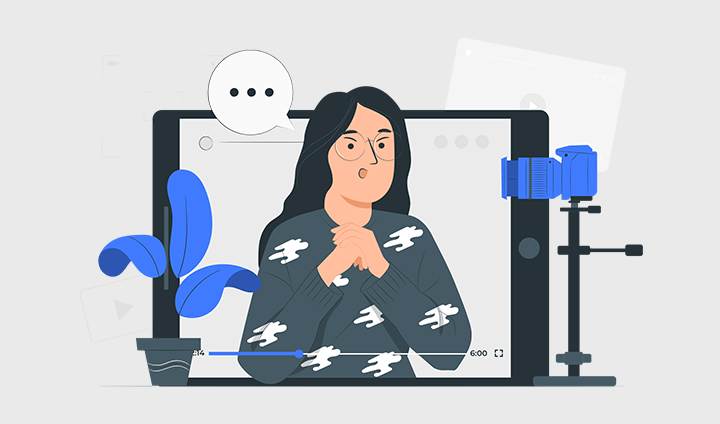
You can also upload a self-hosted video on your website. But, it slows down your site speed. So, we recommend not to use self-hosted videos unless necessary.
Anyway, the reasons for embedding videos on your website are:
- User Engagement: A video is likely to engage visitors longer than just plain text on your website.
- Website Experience: Videos on your website enhance the users’ experience on your site.
- Preference: Some people prefer watching videos over reading articles. So, it’s convenient for them.
How to Rank Videos on Google?
As you might have seen, Google has a separate Videos section. The section has all the relevant videos for users’ search queries.

The video SEO aims to rank videos from other platforms in the Videos section of Google.
Now that you know the importance of optimizing videos, you might want to rank your videos on Google. Some of the measures to rank your videos are as follows:
- Choose a Video Platform: YouTube is used by the majority of people. Also, it’s a fact that Google owns YouTube. So, their algorithms have some similarities in optimizing videos.
- Write the Best Title: Fundamentally, you should write a relevant title that describes the video’s purpose. Also, try including the keywords without altering their meaning.
- Write Description: The description of the video must contain a focus keyword along with other LSI keywords. Plus, try to make it engaging, interesting, and understandable.
- Use Tags: Tags show the relevancy of your video with the search keyword. So, including the related keywords in the tags section (especially on YouTube) is the best idea.
- Transcribe the Video: You should prepare a transcription of your video and use it as the video caption. It makes the video more understandable for viewers as well as Google.
- Use Elegant Thumbnail: Thumbnail is the display image viewers see in your video. So, make sure you use an appealing custom thumbnail.
Well, these are some simple but highly effective on-site SEO tactics that will help you improve your position in SERPs. Now, let’s move ahead to technical SEO.
E. Technical SEO Basics
Technical SEO is enhancing your site’s technical prospects to improve its organic ranking. It aims at improving the internal structure and codes of your website.

In other words, technical SEO is fulfilling the search engines’ technical requirements for crawling and indexing your web pages.
Mainly, the use of good site structure and valid codes makes crawling easier for search engines. Thus, your site can be eligible to rank on the result pages. Other factors include domain structure, page speed, URL structure, security, etc.
As you can see, some on-page SEO factors are included in the technical factors. And, you might wonder if they are similar.
Here’s the fact.
Technical SEO is a part of on-page SEO itself. The on-page SEO includes all the manageable entities of your website, technical SEO manages only its technical aspects. That’s why some SEO factors fall under both on-page and technical factors.
Significance of Off-Page SEO
Now, it’s true that Google always seeks and ranks good quality content. But, finding any content is impossible if your website isn’t technically sound enough for search engines to index and crawl into it. And the worst part, your quality content remains undiscovered.
So, you should focus on improving your site’s technical aspects to rank well.
Key Technical SEO Elements
We have discussed some of the technical SEO factors below.
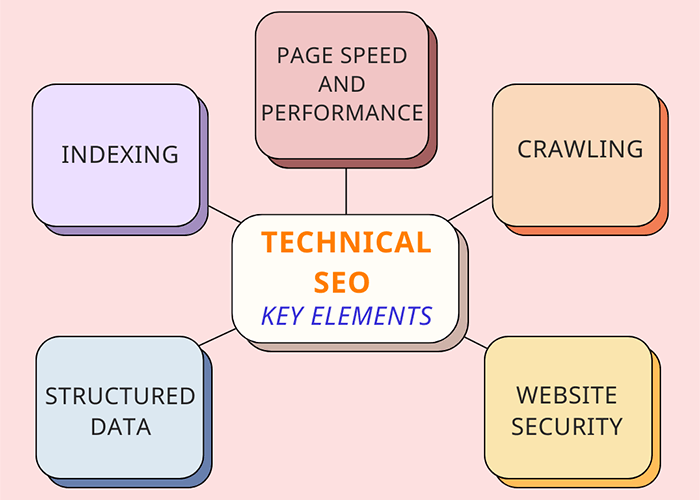
1. Page Speed
Web page speed is a crucial factor that search engines, as well as visitors, like about your website. It is a good indicator of your site’s quality.
According to research, if a web page on Google SERP takes over 3 seconds, then 53% of visitors are likely to click immediately. This applies to users with desktops, laptops, and other devices. It’s a fact that if your site takes more time to load, then you are losing your visitors.

On the other hand, Google keeps track of the so-called ‘Pogo Sticking‘. It is the process of users clicking web pages back immediately within seconds.
And, search engines hate if such events occur more often. In such a case, Google understands that your site isn’t providing a good user experience. And then, it drops down your ranking.
So, you need to reduce your website load speed time.
Various things can determine your web page speed. For example, a powerful browser can make a site load faster. Or, the strength of your internet connection may play a role.
However, here are a few of the things that you can do.
- Purchase a good hosting service for optimum site speed.
- Use lightweight codes for styles and scripts on your site.
- Use optimized images and other media files.
There are various tools available to test your site’s speed. You can use the PageSpeed Insights tool made available by Google.
Find the best speed optimization plugins for WordPress here!
2. Mobile Friendliness
Having a mobile-friendly website is not optional anymore. People are fond of using smartphones for surfing the internet. Stats show that more people browse the internet from mobile devices than on desktops and laptops.
With the popularity of mobile phones, Google has set web pages’ responsiveness as an important ranking factor. So, your website goes a long way in ranking if it’s responsive.
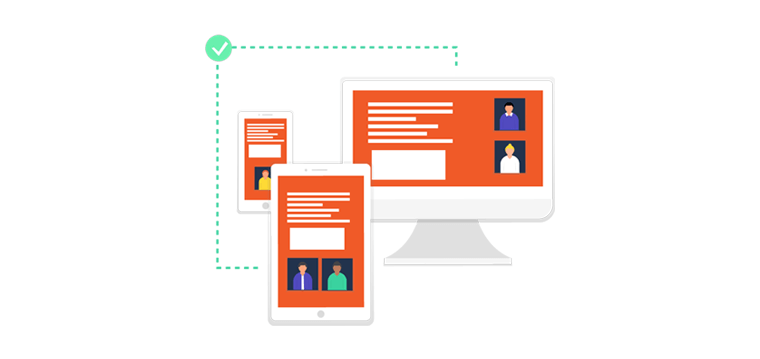
Also, your visitors will be happy if they can access and navigate your site easily through mobile devices.
3. Use of Sitemap
A sitemap is the outline of your website’s structure. It assists in finding all the web pages on your website.

You use a sitemap to provide Google with a list of all the web pages on your site. By doing so, you can ensure that Google doesn’t miss crawling any page of your website. Thus, sitemaps help to index your pages so that they appear on the SERPs.
To keep track of your sitemaps, you can use webmaster tools like Google Search Console. It gives information about your sitemap along with crawling and indexing reports. It also lets you know if any crawling issues occur.
Here’s a list of the best WordPress sitemap plugins for your website.
4. Website Security
Website security and privacy are crucial technical factors to optimize your site. A secure website firstly gains the trust of your users as well as protects your data from external attacks on the web.
People generally tend to quit unsecured web pages immediately. Thus, your website will automatically be losing traffic with an insecure website.

Google realized the importance of secured websites for users. So, it made security one of their most important ranking factors.
So, every website nowadays should have an SSL certificate to rank well. It is a certificate that provides a secure data transmission between the website and your browser.
Spotting a secured website is no big deal. Nowadays, web browsers have made it easier for users.
Simply, you can simply look at the browsers.
An SSL-enabled website starts with ‘https://‘ in its URL. Also, you may see a padlock icon before the site URL. See the image below for an example.

Whereas websites lacking SSL certificates start with ‘http://’. And, most the web browsers like Google Chrome, Firefox, Microsoft Edge, etc. display ‘not secure’ messages for unsecured websites.
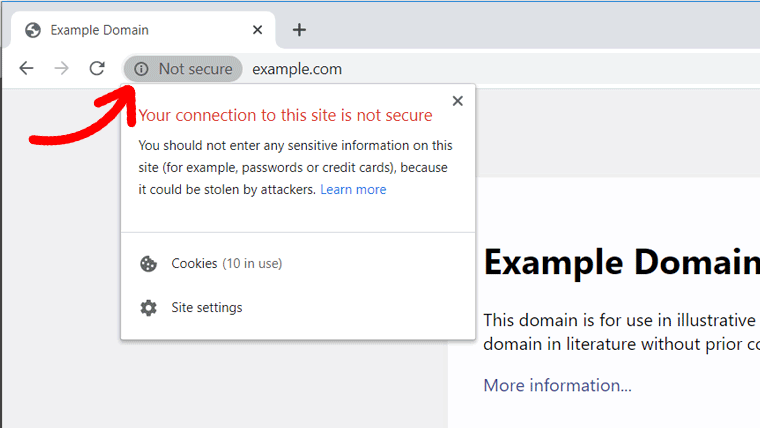
Wondering why your website is saying not secure? Find the reasons and solve them by securing your domain and using one of the best WordPress security plugins.
5. Technical Page Errors
Technical errors on your site will impact your ranking. Errors like dead links, redirects, duplicate content, etc. will make your site dull. It can:
- Those site errors are harmful to the SEO point of view. Also, it creates difficulty for Google and other search engines to properly crawl your web pages.
- Also, you don’t want your visitors to click on your webpage link and land on a blank page. Obviously, it will be frustrating.
The above-mentioned is an example of a broken link (dead link). This usually happens when a web page is deleted or moved. So, you should check for dead links on your web page. You can use various broken link-checking tools available on the web.

Sometimes, your users can come across ‘page not found’ or ‘404 error’ errors. It is a server difficulty to display a requested page. Again, it will be annoying for users to come across 404 errors.
There are various methods to solve these problems. Basically, you can redirect the error page to another page. By doing so, your users don’t have to come across the error page.
Learn why the 404 errors occur and how to fix them here!
6. Structured Data Markup
Structured data refers to information on your website or specific pages for search engine crawlers. It helps describe your content, such as whether it includes a recipe, a product listing, or a user review. In essence, it’s a way to communicate information to search engines in a language they understand.
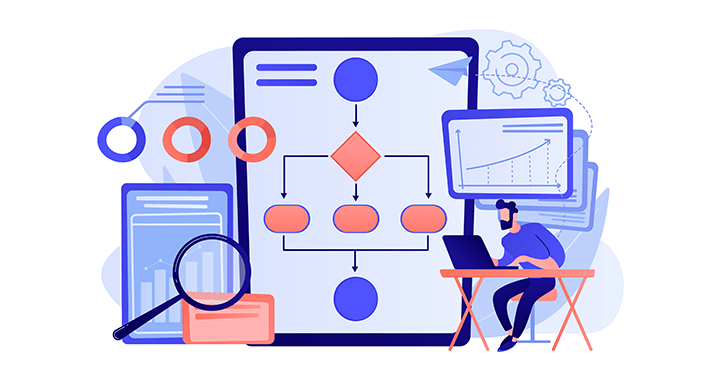
Implementing structured data can enhance your chances of ranking higher in Search Engine Results Pages (SERP) by enabling rich snippets and improving your Click-Through Rate (CTR).
Hence, you can utilize tools like Google’s Structured Data Markup Helper, a free resource that aids in selecting the type of data you want to highlight.
For instance, you might choose an Article markup for blog posts. Once you’ve marked up your page, it’s crucial to verify your implementation using Google’s Structured Data Testing Tool.
F. Off-Page SEO Basics
In simple terms, off-page SEO refers to all your efforts outside your own site (or page) to improve its rank on search engine result pages (SERPS).
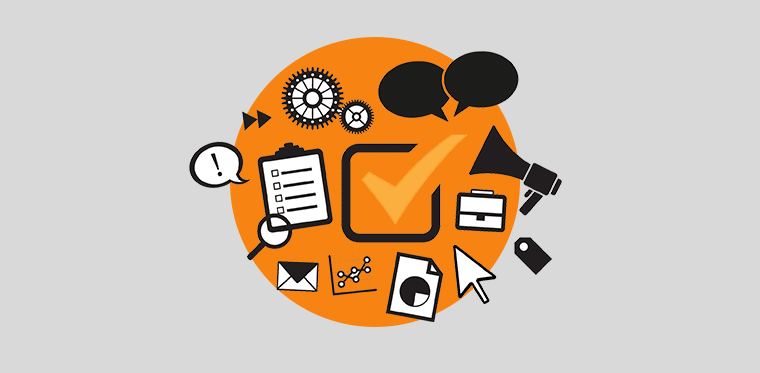
As the phrase itself reveals, it’s the ‘search engine optimization done off the page’. Or the ‘search engine optimization done off the site’, as it’s also commonly called ‘off-site SEO’.
Significance of Off-Page SEO
Off-page SEO includes every activity you’ll do off your site to enhance its search engine rankings. This means that it’s a process of boosting your site’s search engine rankings by using others’ websites or platforms.
As search engines continually refine their ranking algorithms, the specific factors and their respective weights influencing rankings remain uncertain. Thus, the key to fostering a positive image lies in consistently upholding the relevance, authenticity, and authority of your site.
Key Off-Page SEO Elements
Now, let’s dive into the description of some of the off-page SEO elements!
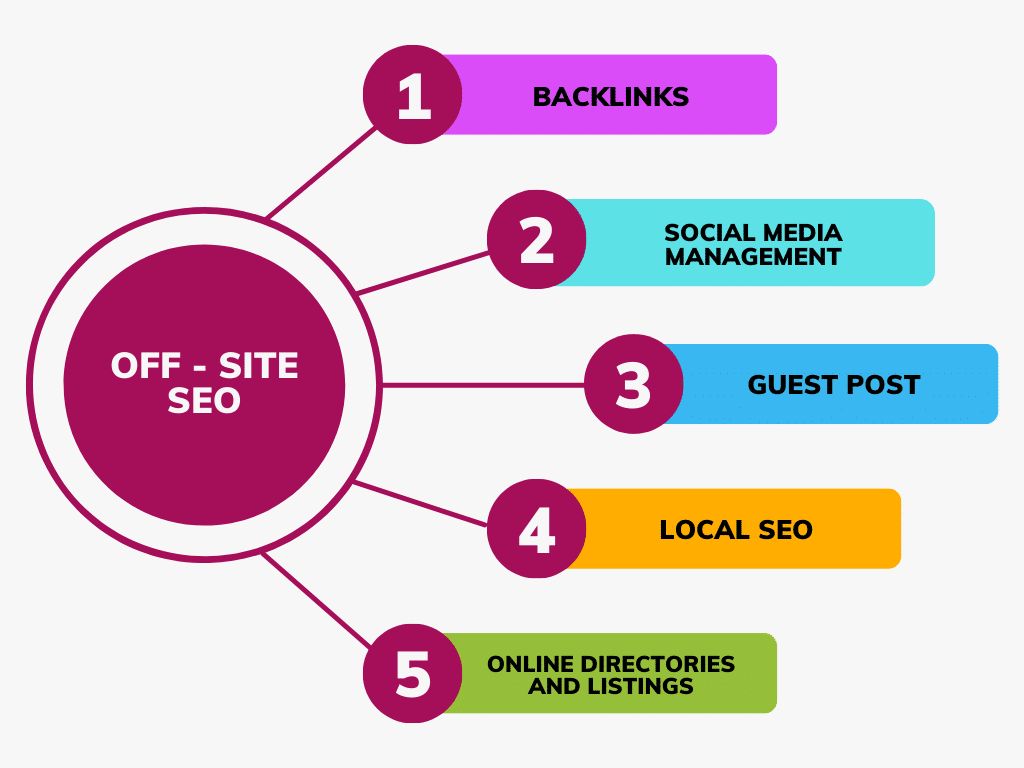
1. Gaining Quality Backlinks
A backlink is simply a link to your site from another website. In other words, if a website links to your site or page, then you get a backlink from them. Similarly, if you link to another website from a page on your site, then they get a backlink from you.
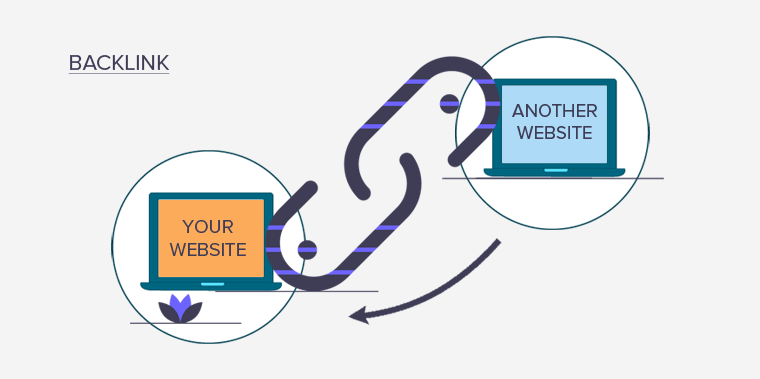
Basically, backlinks are links coming to your site so they’re also called “incoming links” or “inbound links”.
Backlinks are one of the most critical ranking factors as they signify that the site is trustworthy and valuable. If other sites are pointing to your content, then it means your page has really useful content. So, search engines count those backlinks as votes for your site.
So, the web pages with the most backlinks are likely to rank higher on Google.
There are various ways you can get backlinks.
- Naturally, people link to your content if they find your content useful to their audience because you’ve quality content. This means that creating good content (on-page SEO strategy) goes side by side with link building (off-page SEO).
- Another way is guest posting (writing articles on other websites with some links to your site), submitting your website to web directories, etc.
- Some web owners even pay and ask other sites to link their articles. This method comes under black-hat SEO which can rather harm website ranking.
In a nutshell, you should focus on writing quality content to gain natural backlinks. By doing so, you can build quality backlinks.
If you want to check your site’s backlinks, you can use Ahrefs’s free backlink checker tool.
Do All Backlinks Have Equal Value?
Of course, you may get backlinks from various websites.
But, do all the backlinks hold equal importance? The answer is no!
The authority of the site plays an important role. It means that links from websites with more authority have a higher impact on your ranking.
For example, you own a website about movies and series reviews. Then, getting backlinks from IMDb and Rotten Tomatoes is more important than a new movie blog. IMDb and Rotten Tomatoes are the most renowned websites for movie ratings, reviews, and critics.
So, you should target getting backlinks from authoritative websites to rank higher.
Similarly, the relevance between your site and the sites linking back to you is equally important for ranking. The backlinks from a related website count more than those from an irrelevant website.
For example, you own a website about food recipes. Then backlinks from restaurant websites will be more relevant than let’s say a tech blog.

Google’s algorithm looks for relevancy between your site and the site linking you. It examines the anchor texts and other web page content for relevancy. Then, it prioritizes the backlinks obtained for more relevant websites.
Anchor text is the portion of text in which you attach web page URLs. Attaching URLs makes the anchor texts into clickable links that direct you to other web pages.
People, search engines, and other site owners love good content. Fun and interesting content are always ahead of dull, boring content in SERPs too. So, creating the best content is an important on-page as well as an off-page SEO strategy.
Good content triggers readers’ intuition to share your content. Also, an article is likely to be featured on other websites or articles if it’s useful. Having so, the backlinks of your website increase, and then it leads to your site ranking higher.
To make the articles more appealing you should include the following things in your content.
- Photos and Videos
- Diagrams
- Infographics
Also, a good article is informative. It should provide readers with relevant information on the topic your content is about. It’s even better if you can provide facts and data to support the information you’re providing.
3. Marketing Your Website and Content
Marketing your website doesn’t directly affect your ranking. But, it makes your site reach more audiences on different platforms. There are various ways you can promote your website.
Here, we’ll talk briefly about some of the popular online marketing strategies useful to SEO.
- Content Marketing
- Social Media Marketing
- Email Marketing
i. Content Marketing
First, it’s content marketing. Content marketing is a strategy for creating and promoting content. It is an effective technique used by many to gain visitors and rank higher on search engines.
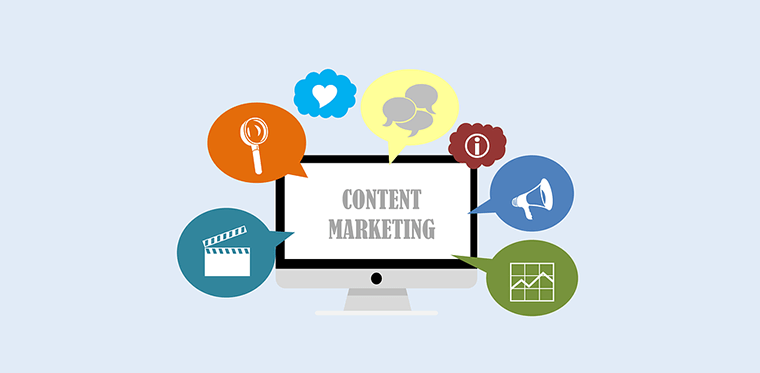
Some of the steps of content marketing are listed below:
- Select Appropriate Niche – Pick the type of article that you are going to write.
- Research Target Audience – Research your future audience based on age, location, background, or other characteristics.
- Know Your Competitors – Look into what your competitors are doing. You may want to point out their best implementations and weaknesses.
- Create Qualitative Content – Write good, readable content based on the research. You should try making it useful, interesting, and fun.
- Promote your Content – You can promote your content through emails, social media, or word-of-mouth measures.
As you market your content, more people will see your content, interact with it, and share it with their friends and followers if they like. So, writing good content isn’t enough, you should do marketing to show people that you’ve created really valuable content.
ii. Social Media Marketing
Second, social media marketing is quite related to content marketing. Social media has been a sensation among users for promoting websites and content. Promoting your content on social media, reaches more people with the probability of more views.
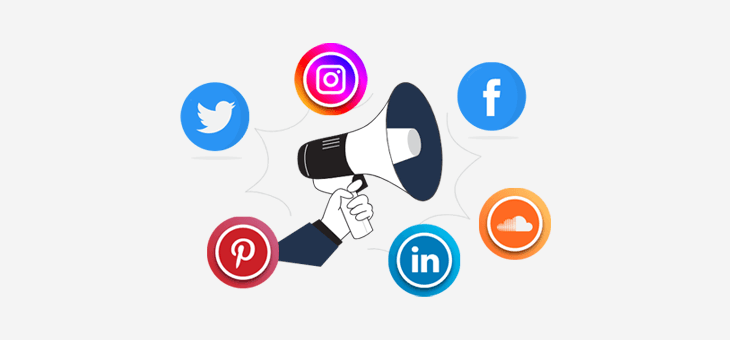
Besides, social sharing buttons on blog posts and articles have become mandatory. This enables the readers to share your content on different various media like Facebook, Twitter, etc.
Although adding share buttons seems like a pure on-page strategy, it also works as an off-page factor. Once your content appears on social platforms, it may lead more new people back to your site. Just like a backlink!
Learn how to add social share buttons in WordPress using social share plugins.
iii. Email Marketing
Another popular way is email marketing; promoting your content through emails. A good number of visitors can be achieved through mail as well. It has been an effective way to gain visitors for decades. And still, it is popular these days.

Usually, webmasters send emails to their subscribers notifying about useful articles, latest products, and services. This process is also known as email marketing.
Besides, you can request your clients, or related websites to link your page to theirs. Or, you can engage in various online forums and blogs. There, you can advertise your articles by posting and commenting.
Find the best email marketing services and if you use WordPress, then here’s a list of the best email marketing plugins.
4. Local SEO
Broadly, local SEO is the process of optimizing your website for searches targeted at a certain area or physical location. Online marketers take it as a marketing strategy to provide products and services to local customers.
Local SEO is adopted by small businesses to gain traffic and grow brand recognition. In other words, it serves as a way of increasing the exposure of your online presence on a local level. It implies that local SEO targets to reach people near your business location.
An example of a local search result:

Local searches usually include similar searches for products and services like fast food, restaurants, café, hospitals, schools, transport services, etc. in a definite area.
Stats show that 46% of Google searches are local searches. It means that nearly half of the searches people initiate are for finding nearby goods and services.
So, optimizing your site for local search is important if you want to be discovered in the SERPs. This way, you can drive more traffic. And eventually, your business conversion rate will increase with more sales.
Local SERP
You might have noticed that Google’s local SERPs are a little different than a normal one.
Let’s see an example.

As you can see, the local search engine result page (SERP) consists of an extra section called local finder/local pack. It includes a Google map pointing out the available options for the search. Also, it shows a list of all the relevant places that are in the desired area.
So, you might want your website to pop up in the local finder section of the local SERP. For that, Google provides a tool called Google My Business (GMB).

It is a free tool that lets you create a business profile and provides a user dashboard. Using that, you can add information like service details, contact info, Google Maps location, average ratings, reviews, website URL, etc.
Then, Google displays your profile on the local finder section whenever searches relating to your service and location take place.
But the ranking of your website or services depends not only on the search query. It depends on other factors too.
How to Optimize Your Website for Local Search?
Optimizing your site for local search is similar to other normal SEO measures. However, it includes other few more strategies for achieving optimum rank. They are:
- Updating Citation: Citation is your business information like name, address, and phone number (NAP) that you put online. Make sure that you enter those same details every place like on the website, GMB profile, business directories, etc.
- Add your website location: You should add the location of your service on Google Maps. It helps the users to discover the physical location of your business. Also, Google Maps can provide a direction to reach you if you have a presence on Google Maps.
- Good ratings and reviews: Your profile is ranked higher if you have good ratings and reviews. The ratings and reviews are given by your customers based on the quality of services they get. So, aim to give the best services to your customers.
- Local Content: You should create content targeting to attract the local audience. You can create an informative blog about your business. It helps readers to have a better idea about your services.
- Word of Mouth: It means personally requesting your friends and colleagues to spread good words about your business.
These strategies may not have a direct impact on your rankings, but they’re really important for sustainable SEO.
G. White Hat SEO vs Black Hat SEO
As you are clear now about the purpose of SEO is to rank higher and gain visitors. So, to achieve a good ranking, web owners practice different kinds of ranking strategies.

Some tactics aim to score good ranks with qualitative and useful content for users. While some websites only try to achieve good ranks careless of the quality they deliver. Some even seem to violate the search engine guidelines.
It’s not a secret that search engines’ goal is to rank the most relevant content higher. Taking advantage of it, many websites make their useless content look relevant to search engines.
Based on the strategies websites apply, we can divide SEO into 2 types: Black Hat SEO and White Hat SEO.
From the name you might guess that white hat SEO is the proper use of search engine guidelines to rank higher. Whereas black hat SEO is tricking search engines to give the website a better rank.
White Hat SEO
White hat SEO primarily focuses on providing quality content to visitors.
To rank your site, white hat SEO encourages adopting ethical measures. Although the ranking process is slow, it is consistent and steadily improving. Thus, experts suggest using white hat SEO for long-lasting and sustainable results in your site’s ranking.
Most of the commonly used SEO practices come under the white hat SEO. Some of them are:
| White Hat Practices | Description |
| Creating quality content | Qualitative content is the pillar of the whitehat SEO. It enhances other SEO factors like engagement, site time, interaction, etc. Also, people are always likely to read and share good content. |
| Optimizing Technical Aspects | Technical factors like site speed, mobile-friendliness, security, etc. affect users’ experience on your site. Similarly, a good URL structure is useful to understand the content of the web page in SERPs. |
| User Interface | A good user interface makes your site appealing to visitors and easy to navigate. If your site has an appealing design, people are likely to stay more. This saves your site from bounces and pogo-sticking too. |
| Building Links | You should focus on building quality backlinks from other websites. It gets your website more exposure and visitors. Also, Google ranks your website higher if the backlinks are pointed from more authoritative and relevant websites. |
Black Hat SEO
Black Hat SEO aims to rank higher in result pages without providing useful and relevant content to users. This technique tricks search engines think vague web pages as useful.
Black hat SEO may be effective for ranking your site higher. But not for long, it only lasts for some time on a higher rank.
Also, it’s too risky to apply those tricks nowadays. With major algorithm updates, Google has become smarter day by day.
If Google finds any unusual methods used to rank your site, then you’ll be penalized. Either your site’s rank drops or will be blacklisted.
Some of the commonly used black hat SEO techniques to avoid are:
| Black Hat SEO | Description |
| Keyword Stuffing | Websites use keywords an excessive number of times in an article or web page to rank for that keyword. The keywords stuffed content or web page deceives Google to understand it as most relevant for that keyword. But in reality, it doesn’t provide much value to readers. |
| Link Spamming | People are seen to post and comment links and keywords on forums and blog posts multiple times. But this trick won’t work to mislead Google into thinking the web page is popular and rank it. |
| Cloaking | It is the process of tricking Google by displaying a different page than what people are seeing. It is done to hide the actual content of the page and make Google bots crawl a different page. For example, some websites have spammy content. They try to hide it from Google by cloaking it with a clean web page. In doing so, people will come across their spammy web page when they open the URL. While Google finds the same URL fine. |
| Texts Hiding | It is the process of making texts, generally keywords invisible to the readers’ eyes. Generally, it is done by changing text color matching its background. This way, the article seems readable to the users. Also, it’s supposedly done to rank for the hidden keywords. |
| Article Scraping | Sometimes, people use bots to collect and assemble content from different sites. Then, they rephrase the words and make it look a little unique. This technique may have worked in the past. But, with advanced Google algorithms, it’s impossible to rank such articles. |
| Artificial Link Building | Any unnatural process of building backlinks comes under artificial link building. It includes buying and selling links (exchanging money with links), mutually exchanging links, exchanging links with services/products, etc. |
H. SEO Trends and Future Developments
The field of SEO is in a constant state of flux, adapting to the continuous evolution of search engine algorithms and shifts in user behavior. To remain at the forefront, it’s crucial to embrace SEO trends that promise to redefine the approach to website optimization.
Moreover, you must be aware of what the future brings and be proactive enough to strengthen your SEO game now. Keeping that in mind, here are some SEO trends and future developments to consider.
1. Role of AI for SEO
Artificial Intelligence (AI) empowers machines to learn from data and execute tasks typically requiring human intelligence. In the realm of SEO, AI has a profound impact, offering capabilities to optimize websites and content for both search engines and users.
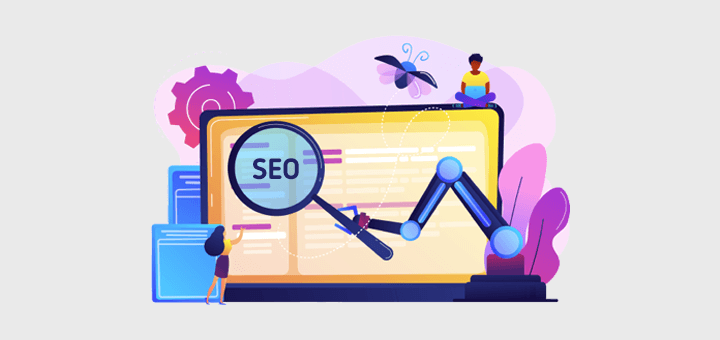
AI’s contributions to SEO include:
- Content Enhancement: AI analyzes user data to anticipate preferences, facilitating the creation of captivating content that retains user attention.
- Intelligent Keyword Generation: Move beyond keyword stuffing as AI generates headlines, meta descriptions, and structured data that resonate with human language while pleasing search engines.
- Enhanced User Experience: AI plays a role in improving website speed, design, and navigation, ensuring users stay engaged, explore deeper, and convert seamlessly.
- Adaptive Strategies: AI keeps pace with ever-changing search engine algorithms, continuously adjusting strategies for optimal performance.
AI proves to be a valuable tool for SEO to outpace competitors. So, even in 2024, it’s viewed as a helper rather than a substitute for human creativity and expertise. Hence, you should also take it as a tool to automate and enhance the SEO process.
Here are some AI rewrite tools that can help you write SEO-optimized content.
2. Expansion of Google’s EEAT
This year, Google is placing a strong emphasis on Expertise, Experience, Authoritativeness, and Trustworthiness (EEAT) factors for extensive online searches. Google analyzes these factors to evaluate the website quality for presenting the best and most reliable content.
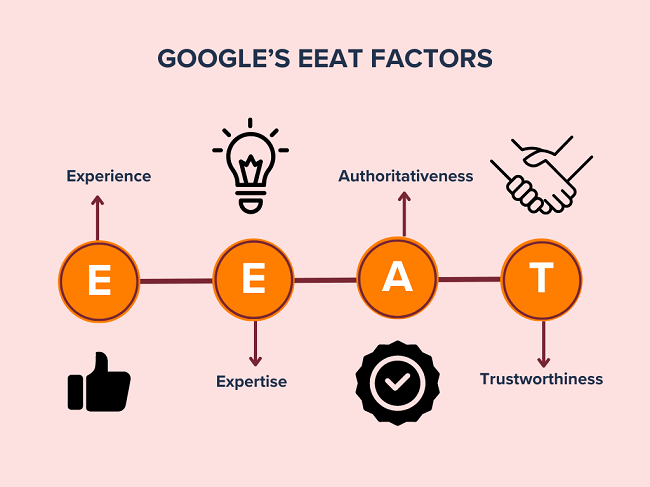
Thus, EEAT is significant for improving search result rankings. Let’s break down the EEAT factors for better understanding:
| EEAT Factors | Definition | Process | Significance |
| Experience | Knowledge and skills acquired through education, training, and work experience. | Showcase awards, publications, and testimonials to demonstrate expertise. | Indicates that you possess the necessary knowledge and skills to produce trustworthy content, showcasing commitment and staying current in your field. |
| Expertise | The capability to utilize knowledge and skills to solve issues or answer questions. | Showcase through writing, research, and citation of sources. | Highlights your expertise in the field, showcasing your ability to provide accurate and quality information. |
| Authoritativeness | The perceived credibility of a source of information. | Based on your quality backlinks, social media engagement, and citations. | Indicates that your website is a trusted source of information, with relevant and valuable content for users. |
| Trustworthiness | The perception that a source of information is honest, unbiased, and reliable. | According to transparency, accuracy, and neutrality. | Demonstrates your website as a reliable source of information, emphasizing the accuracy and impartiality of your content. |
3. Social Media as a Search Engine
Social media platforms have transformed from mere connectors to dynamic search engines. Users now rely on platforms like Facebook, Twitter, Instagram, and LinkedIn not just for socializing but also to discover information, products, and services.
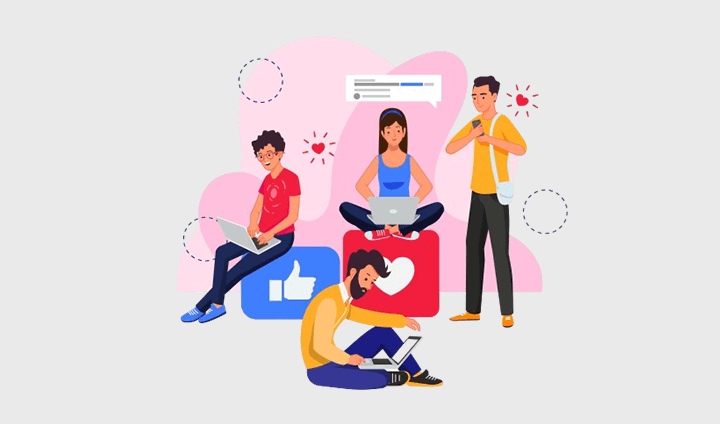
The real-time nature of social media provides immediate access to user-generated content, offering relevant search results. With embedded search functionalities, users can explore topics from trending news to niche interests.
This transformation is driven by several factors, including the vast amount of data generated and shared by users, and the algorithms employed by these platforms. Here are a few key aspects that highlight the emergence of social media as a search engine:
- Real-time Updates: Social media provides instant updates on current events, trends, and discussions, allowing users to access the latest information.
- User-Generated Content: User-generated content on social media platforms contributes to a diverse pool of information that users can search through.
- Targeted Discovery: Social media algorithms use user behavior and preferences to offer personalized content, enhancing the relevance of search results.
- Visual Search: Platforms like Instagram and Pinterest allow users to search for content using images, promoting an intuitive search experience.
- Community Engagement: Social media facilitates engagement with communities of interest, encouraging users to share and discover information within their networks.
As social media platforms enhance search features, they are poised to further solidify their role as dynamic search engines, influencing how people navigate and access information online.
4. Google’s Search Generative Experience (SGE)
Google Search Generative Experience (SGE) was introduced during the Google I/O conference in 2023. This innovative feature represents a significant leap forward in the evolution of search engines, as it integrates AI-generated insights alongside traditional search results.
The primary objective of SGE is to enhance the overall search experience by leveraging artificial intelligence to dynamically generate relevant and contextually rich content for users.
As SGE is experimental, it will likely support and enhance Google’s ad business model. Meaning, we must know that Google will prioritize features on websites that link to revenue generation. That’s how organic and paid content can work together in SERPS.
I. How to Do SEO for Your Website Yourself?
Now that you are familiar with all the aspects of SEO, you might be thinking of applying it to rank your website. Don’t worry! The basics of SEO are quite simpler than you think. i.e. you don’t necessarily have a technical background or a degree in SEO.
You just have to implement some important practices for better ranking of your website. Here is an SEO checklist for you to get started!
1. Domain Name: Select a short domain name that matches your website’s niche. Try to make it shorter, up to 15 characters, preferably. Also, try to get a .com extension. You can get it from a domain registrar, so consider picking the best domain registrars.

2. Site Speed: Use lightweight codes, good web hosting, and optimized media to make your site load faster. See our website speed optimization guide and pick the best hosting for SEO.
3. Mobile-Friendliness: Make your website load easily on mobile phones and tablets too.
4. Security: Ensure that you include an SSL certificate on your website to make it secure. Check out our definitive website security guide for a complete idea.
5. Website Design: Make your website appealing to visitors. Use nice colors, and neat animations, and make navigation easy.
5. Content Quality: Create original and readable content. Check if the content is grammatically correct and not plagiarised. Fill your content with engaging media, figures, and useful information.
6. Use Keywords: Research and use keywords appropriately. Make use of online tools to find the most ranking keywords and their related LSI keywords.

7. Optimize URL Structure: Make the URLs short and clear of what the content is about. Also, include the main keyword in URLs.
8. Give Internal and External Links: Make sure you use adequate internal links in your blog posts.
9. Optimize Images: Use minified images to save up your hosting space to make your site load faster. But ensure that the quality is still good. Also, insert alt text and caption for accessibility.
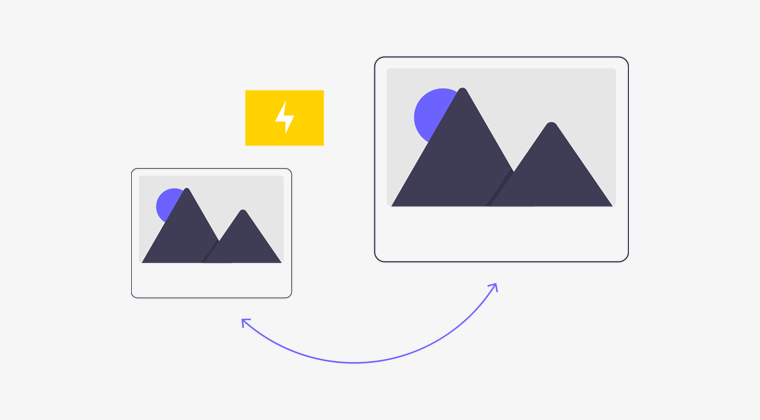
10. Focus on Building Backlinks: Use strategies to gain backlinks from authoritative and relevant sites.
Handling your SEO yourself can be a money and time-saving choice, offering control and flexibility. However, it demands patience, dedication, and a willingness to experiment.
Learn how to do SEO yourself here!
J. How to Use AI for Your Site’s SEO?
Instead of doing everything yourself, you can take the help of AI to optimize your website’s SEO. Believe it or not, you can use AI to perform several key SEO practices.
Learn some of the crucial ways to use AI for your site’s SEO by following the steps below:
1. AI-driven Keyword Research: First, pick an AI-driven keyword research tool based on your budget. It can be Semrush, Ahrefs, etc. For example, the Keyword Magic Tool of Semrush helps you discover new keywords with their insights. Just enter the keyword and click ‘Search‘.
There you have it! Relevant keywords with related and long-tail keywords. Learn using Semrush here!

2. AI-Powered Search Intent Analysis: SEO tools like Semrush let you identify the search intent of the keywords you want to rank for. This helps you understand your audience’s queries and requirements. For example, the same Keyword Magic Tool provides the intent of the keywords.
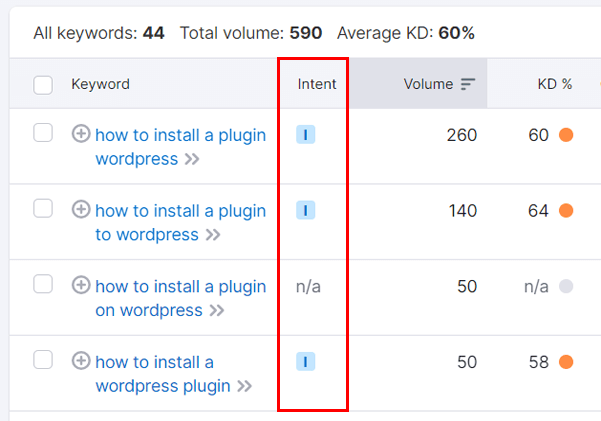
3. Competitor Analysis Using AI: Semrush, Moz, etc., are the tools for competitor analysis. For instance, use the Domain Overview of Sermush to compare the competitors’s strengths, weaknesses, progress, etc. Insert the competitor’s domain and compare it with yours or others.
4. AI Content Generation: AI tools like ChatGPT are popular for content generation. Simply, provide a prompt stating your needs and within seconds you’ll get the content.
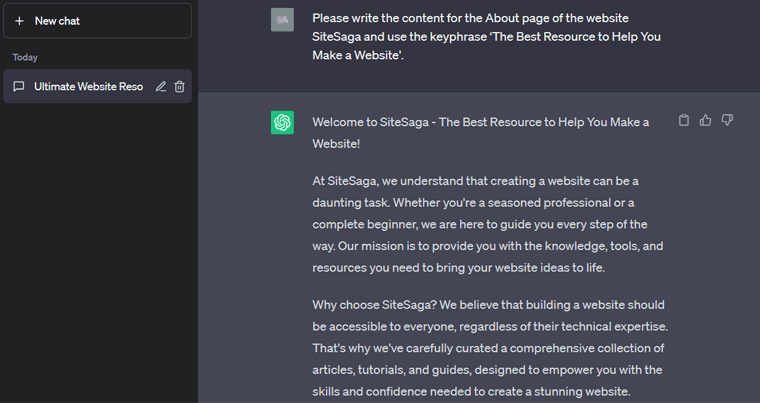
5. On-Page Optimization with AI: Utilize tools like Rank Math and SurferSEO. Using Rank Math‘s Content AI module in WordPress, lets you add the keyword and get suggestions for on-page optimization.
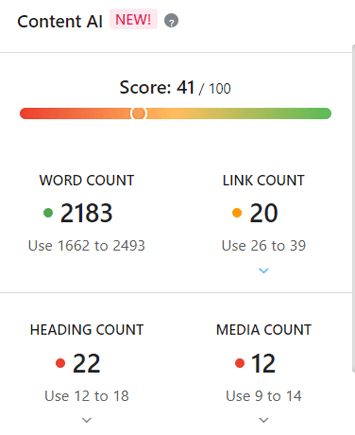
6. Link Building: Semrush and Majestic contain link-building features. Just open Semrush, enter your domain in the link-building tool, and insert the competitors. You’ll get possible prospects.
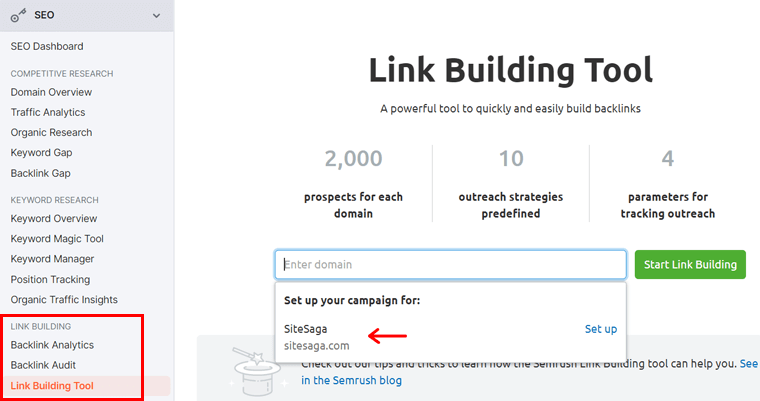
7. Voice Search Optimization: With the rise of voice search, it’s a vital part of SEO. AI tools like Semrush and Majestic have features for finding keywords, content creation, and optimization.
8. User Experience and Mobile Optimization: Google Search Console and Google Analytics are the tools that let you find insights on user behavior, bounce rate, and engagement elements of your site.
9. Reporting: Most SEO tools help you track your website. For example, the Position Tracking tool of Semrush provides ranking insights of your website for your target keywords.
Learn how to use AI for SEO in detail here!
Conclusion
We hope this guide helped you understand what is SEO, how it works, and also how to do SEO for your website. Also, we hope that you’ll be able to improve your website SEO by applying the guidelines and suggestions we’ve given.
If you need any further SEO suggestions, then please leave a comment below. We’ll try to get back to you as soon as possible. You can also post your feedback and suggestions for this guide.
You may also want to check our guide on the best SEO rank-tracking tools, the best WordPress SEO plugins, and the best SEO website builders.
And, follow us on Facebook and Twitter for more.
